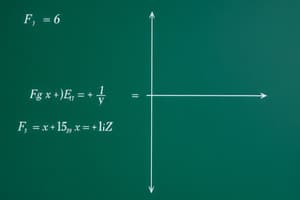Podcast
Questions and Answers
Which of the following is NOT a key assumption of linear programming?
Which of the following is NOT a key assumption of linear programming?
- Certainty of all parameters within the model
- Divisibility of decision variables into fractional values
- Linearity in the objective function and constraints
- Non-negativity of all constraint coefficients (correct)
In linear programming, what does the feasible region represent?
In linear programming, what does the feasible region represent?
- The set of all possible solutions that satisfy all the constraints. (correct)
- The set of decision variables that optimize the objective function.
- The set of constraints that the decision variables must satisfy.
- The set of all possible values for the objective function.
What is the economic interpretation of the shadow price in linear programming duality?
What is the economic interpretation of the shadow price in linear programming duality?
- The reduction in the objective function value due to a constraint.
- The cost of one more unit of a decision variable.
- The cost of increasing a constraint's limit by one unit.
- The change in the optimal objective function value for a one-unit increase in the availability of a resource. (correct)
Which method is most suitable for solving a linear programming problem with two decision variables?
Which method is most suitable for solving a linear programming problem with two decision variables?
In the simplex method, what criterion is typically used to select the 'entering variable'?
In the simplex method, what criterion is typically used to select the 'entering variable'?
What distinguishes integer programming (IP) from linear programming (LP)?
What distinguishes integer programming (IP) from linear programming (LP)?
Which of the following is NOT a typical application of linear programming?
Which of the following is NOT a typical application of linear programming?
What information does the 'allowable increase' and 'allowable decrease' provide in sensitivity analysis?
What information does the 'allowable increase' and 'allowable decrease' provide in sensitivity analysis?
What is the purpose of introducing slack, surplus, and artificial variables in the simplex method?
What is the purpose of introducing slack, surplus, and artificial variables in the simplex method?
Which type of integer programming restricts decision variables to either 0 or 1?
Which type of integer programming restricts decision variables to either 0 or 1?
Flashcards
Linear Programming (LP)
Linear Programming (LP)
Finding the best outcome given a mathematical model represented by linear relationships, such as maximum profit or lowest cost.
Objective Function
Objective Function
A mathematical expression representing the goal to maximize or minimize in a linear programming problem.
Constraints
Constraints
Restrictions expressed as linear equations or inequalities that must be satisfied in a linear programming problem.
Decision Variables
Decision Variables
Signup and view all the flashcards
Feasible Region
Feasible Region
Signup and view all the flashcards
Optimal Solution
Optimal Solution
Signup and view all the flashcards
Non-negativity Constraints
Non-negativity Constraints
Signup and view all the flashcards
Graphical Method
Graphical Method
Signup and view all the flashcards
Simplex Method
Simplex Method
Signup and view all the flashcards
Duality in Linear Programming
Duality in Linear Programming
Signup and view all the flashcards
Study Notes
- Operations research (OR) uses advanced analytical methods for better decision-making.
- OR is considered a subfield of mathematics, computer science, and industrial engineering.
- OR assists organizations in achieving goals by providing optimal solutions to complex problems.
- These problems usually concern the allocation of scarce resources.
- The field uses problem-solving techniques and methods to improve decision-making and efficiency.
- OR uses mathematical modeling, statistics, and optimization to find optimal or near-optimal solutions.
Linear Programming (LP)
- Linear programming (LP) is a mathematical technique to find the best outcome using linear relationships.
- LP optimizes a linear objective function subject to linear equality and inequality constraints.
- A linear program has decision variables, an objective function, and constraints.
- Decision variables are the quantities that the decision-maker controls.
- The objective function is a linear expression of the decision variables, which the decision-maker wants to maximize or minimize.
- Constraints are linear equalities or inequalities.
- LP problems are solved using graphical, simplex, and interior-point methods.
Key Concepts in Linear Programming
- Objective Function: A mathematical expression representing the goal (maximize or minimize).
- Constraints: Limitations expressed as linear equations or inequalities.
- Decision Variables: Unknowns to be determined for the optimal solution.
- Feasible Region: The set of solutions that satisfy all constraints.
- Optimal Solution: The point in the feasible region that gives the best objective function value.
- Non-negativity Constraints: Decision variables must be non-negative (≥ 0).
Assumptions of Linear Programming
- Linearity: Relationships between variables are linear.
- Divisibility: Decision variables can take fractional values.
- Certainty: Parameters are known and constant.
- Additivity: Total objective function value and resource usage are sums of individual contributions.
- Non-negativity: Decision variables must be non-negative.
Standard Form of a Linear Programming Problem
- Maximize or minimize: Z = c1x1 + c2x2 + ... + cnxn
- Subject to:
- a11x1 + a12x2 + ... + a1nxn ≤ b1
- a21x1 + a22x2 + ... + a2nxn ≤ b2
- ...
- am1x1 + am2x2 + ... + amnxn ≤ bm
- xi ≥ 0 for all i (non-negativity constraints)
- Where:
- Z is the value to be optimized.
- xi are the decision variables.
- ci are objective function coefficients.
- aij are constraint coefficients.
- bi are the right-hand side values of the constraints.
Graphical Method
- The graphical method solves linear programming problems with two decision variables.
- Each constraint is graphed as a line on a coordinate plane.
- The feasible region satisfies all constraints simultaneously.
- Determine the corner points of the feasible region.
- Evaluate the objective function at each corner point to find the optimal solution.
- The corner point with the best objective function value is the optimal solution.
Applications of Linear Programming
- Resource Allocation: Optimizing the use of limited resources.
- Production Planning: Determining optimal production levels to meet demand at minimum cost.
- Inventory Management: Managing inventory to minimize costs and avoid stockouts.
- Transportation and Logistics: Finding efficient routes and schedules.
- Financial Planning: Optimizing investment portfolios.
- Blending Problems: Determining the optimal mix of ingredients to meet requirements at minimum cost.
The Simplex Method
- The simplex method is an iterative algorithm for solving linear programming problems.
- It systematically examines corner points of the feasible region to find the optimal solution.
- Convert the linear programming problem into standard form.
- Introduce slack, surplus, and artificial variables to convert inequalities into equalities.
- Set up the initial simplex tableau.
- Perform iterations until the optimal solution is reached.
- In each iteration, select the entering variable (most negative coefficient in the objective row) and the leaving variable (determined by the minimum ratio test).
- Update the tableau using row operations.
Duality in Linear Programming
- Every linear programming problem (primal) has a dual problem.
- The dual problem provides insights into the economic interpretation of the primal problem.
- The optimal solution to the dual problem gives information about shadow prices.
- Shadow price is the change in the optimal objective function value for a one-unit increase in a resource.
- If the primal is maximization, the dual is minimization, and vice versa.
- Dual problem variables correspond to primal problem constraints, and vice versa.
- Dual objective function coefficients are the right-hand side values of primal constraints, and vice versa.
Sensitivity Analysis
- Sensitivity analysis assesses how changes in input parameters affect the optimal solution.
- It helps understand the solution's robustness and identify critical parameters.
- Shadow Prices: Indicate the change in the optimal objective function value for a one-unit increase in resource availability.
- Allowable Increase/Decrease: Specifies the range within which variable coefficients or constraint values can change without affecting the optimality.
- Reduced Cost: The amount by which the objective function coefficient of a non-basic variable must improve before it becomes part of the optimal solution.
Integer Programming
- Integer programming (IP) restricts some or all variables to be integers.
- It is employed when decision variables represent discrete, non-fractional entities.
- Types of IP:
- Pure Integer Programming restricts all decision variables to integers.
- Mixed Integer Programming allows some decision variables to be integers, while others are continuous.
- Binary Integer Programming restricts decision variables to 0 or 1.
Common Techniques for Solving Integer Programming Problems
- Branch and Bound: Explores the feasible region by dividing it into subproblems and setting bounds.
- Cutting Plane Methods: Add constraints to reduce the feasible region towards integer values.
- Heuristic Methods: Provide near-optimal solutions quickly.
Applications of Integer Programming
- Facility Location: Determines the optimal location of facilities.
- Scheduling Problems: Schedules tasks, jobs, or resources.
- Capital Budgeting: Selects the optimal set of investment projects.
- Set Covering and Partitioning: Covers or partitions sets of elements.
Limitations of Linear Programming
- Linear programming assumes linearity, which may not hold in real-world problems.
- The certainty assumption may be invalid due to uncertainty.
- The divisibility assumption may not be appropriate for integer variables.
- Models can become complex for large-scale problems.
Software for Solving Linear Programming Problems
- Software packages available:
- CPLEX
- Gurobi
- LINDO
- MATLAB
- Excel Solver
- These packages use advanced algorithms to solve large-scale problems.
Studying That Suits You
Use AI to generate personalized quizzes and flashcards to suit your learning preferences.




